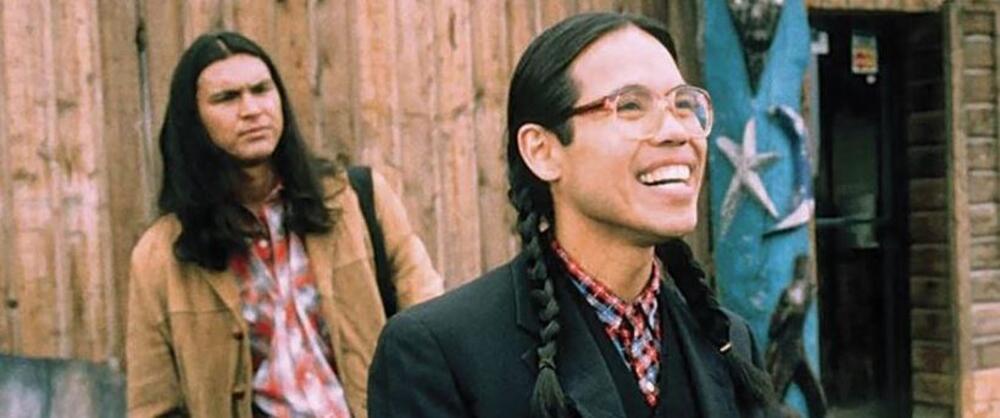Film Notes: SMOKE SIGNALS
SMOKE SIGNALS
7 p.m. Friday, Nov. 17, 2023
Humanities Quadrangle, Room L02 (320 York)
Introduction and Film Notes by Archer Neilson
PDF
Directed by Chris Eyre (1998), 89 mins
Written by sherman Alexie
Cinematography by Brian Carpener
Produced by Miramax
Starring Adam Beach, Evan Adams, Irene Bedard, Gary Farmer, Tantoo Cardinal, Cody Lightning, and Simon Baker
Marketed as the first film written, directed, acted, and co-produced by Native Americans to have a major distribution deal (with Miramax), Smoke Signals has remained one of the most beloved, critically-acclaimed, and frequently-taught Native films over the 25 years since its release. It was also the first film by director Chris Eyre (Skins, Edge of America), and the first screenplay by Sherman Alexie (The Business of Fancydancing). The pair began developing the project in 1995, attending the Sundance Institute Screenwriters Lab and adapting the script from stories in Alexie’s collection The Lone Ranger and Tonto Fistfight in Heaven.
In Smoke Signals, the death of long-absent Arnold Joseph (Gary Farmer)—seen as a deadbeat dad by his son Victor (Adam Beach) and as an heroic surrogate father figure by Victor’s sometimes-sidekick Thomas (Evan Adams)—spurs the two young men to set off from Idaho’s Coeur d’Alene Reservation on a road trip across the American West to Arnold’s Arizona home. Along the way, they joke about native stereotypes and (unsuccessfully) adopt the personae of warriors who “just came back from killing a buffalo.” “Smoke Signals’ emphasis on combating mistaken ideas about Native Americans is closely linked to the personal development of the two protagonists throughout the film,” writes Johanna Feier. Their “journey to Phoenix turns into a quest for their identities as modern-day American Indians… However, before Victor and Thomas can understand what it means to be ‘real’ Native Americans, they must first overcome their internalized cultural stereotypes about their people.”
Throughout the film, Victor and Joseph make it clear that many of these stereotypes came to them from the movies. Amanda Cobb reminds us that “Native people are not merely objects of popular culture; they are also consumers of and participants in that very culture that capitalizes on their distorted and manipulated representation.” (“Indians watching Indians on TV,” as Thomas puts it.) With a consciousness of that history, Eyre plays with mainstream cinematic representation of Native Americans in his image-making. Alexie observes, “There are these gorgeous landscape vista shots of these two Indian guys walking along, and some of them are very western-looking shots—very John Ford-ish—and you'd expect these guys to be on horseback. But no, it's these two Indians in western shirts and JanSport backpacks. So even how they dress totally contradicts all perceived information about Indians.”
The film also reacts against the stoic “good Indian” stereotype found in ‘90s Hollywood hits like Dances with Wolves (1990), The Last of the Mohicans (1992), and Pocahontas (1995). Chris Eyre claims, “The romantic stuff grosses me out! There's Native America, and then there's America's Native America… I want to get away from the romantic stuff. Indian people are like anybody—complicated people.” Alexie concurs, remarking, “I didn't want to make some New-Age film that people could interpret as these ‘Indian magical creatures’—this closeness to the earth, talking to birds and animals. I wanted to make something a lot more subversive than that.”
Hearne notes that the film “signaled a generational shift in Native artistic production toward young writers and artists immersed in the same media they set out to subvert, with its film-school-trained director and media-fluent literary star writer.” It was one of three Native-directed features to premiere at the Sundance Film Festival in 1998, along with Ian Skordin’s Tushka and Valerie Red-Horse’s Naturally Native. Smoke Signals won the Filmmaker’s Trophy (for Eyre) and the Audience Award at Sundance, it enjoyed favorable reviews from critics, and it earned more than three times its budget at the box office. In 2018, it was selected for the Library of Congress’s National Film Registry.
DID YOU KNOW: Evan Adams, who won an Independent Spirit Best Debut Performance Award for playing Thomas, is now a physician and the Chief Medical Officer of the First Nations Health Authority in British Columbia. He still acts occasionally, including a guest appearance as an Indian Health Service psychologist on Reservation Dogs earlier this year.
Presented in Treasures from the Yale Film Archive, with support from Paul L. Joskow '70 M.Phil., '72 Ph.D. Printed Film Notes are distributed to the audience before each Treasures screening.
